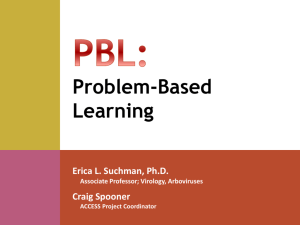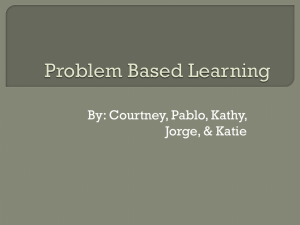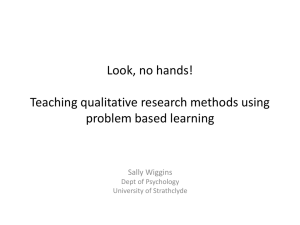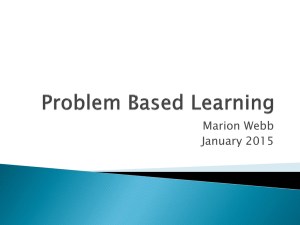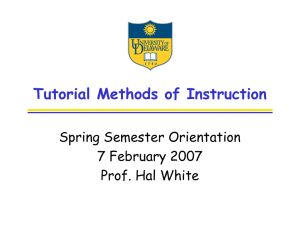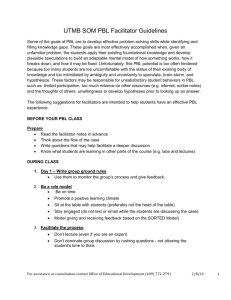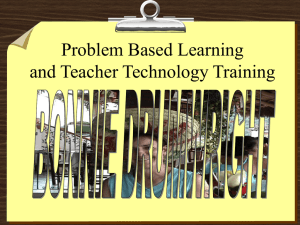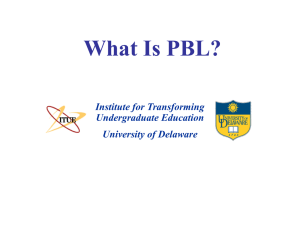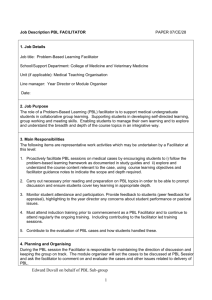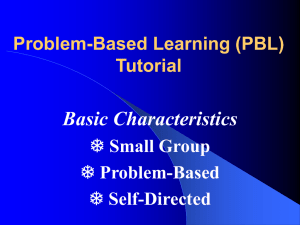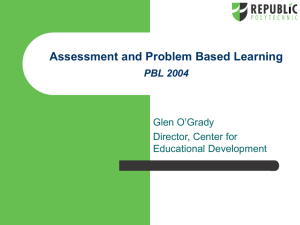Intro-to-Case-Based-Learning-ASMCUE
advertisement
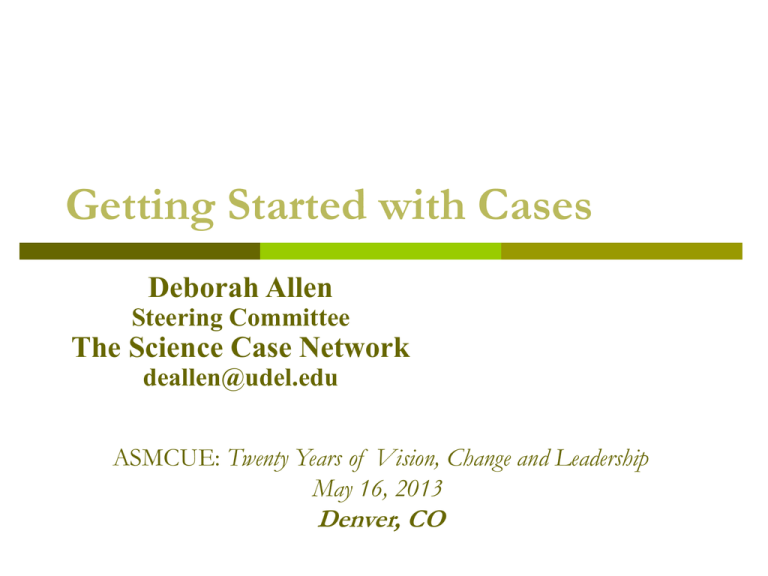
Getting Started with Cases Deborah Allen Steering Committee The Science Case Network deallen@udel.edu ASMCUE: Twenty Years of Vision, Change and Leadership May 16, 2013 Denver, CO Problem-Based Learning & Case Study Method: What’s the Difference? The Early Models Problem-Based Learning Case Study Method Student-centered Instructor-centered Small Whole class Cases as extension, application of concepts group Problems concepts before The Modern Synthesis It starts with a story….. based on complex, real-world situations Students work in groups. Students gain new information through self-directed learning. Instructors act as facilitators and designers of learning experiences and opportunities. Learning is active, integrated, cumulative, and connected. Still a difference? Case as application versus case as means to launch new learning? Perceived ‘Problems’ with Medical Education Problem-based learning was devised > 30 years ago to address the following perceptions: Medical students had difficulty transferring basic science knowledge to clinical applications Expanding knowledge base was leading to ‘information overload’ Solutions: Learn content in context, and learn how to learn Degradative Cycle (Futile Cycle?) Energy and Raw Materials hot air Students Forget waste cellulose Students Remember Students Pass Exam midnight oil Source: E. J. Wood, Department of Biochemistry & Molecular Biology, University of Leeds, Leeds, UK What Is Case-Based Learning? “The principal idea behind PBL [case-based learning] is not new, indeed it is older than formal education itself. It is that the starting point for learning should be a problem, a query, or a puzzle that the learner wishes to solve.” Boud, D. (1985) PBL in perspective. In “PBL in Education for the Professions,” D. J. Boud (ed); p. 13. Experience It Yourself: ELVIS Meltdown 1. 2. Using light microscopy, you examine the soil samples and the “goo” from the degraded polyurethane. Will this approach allow you to observe all microorganisms present in the samples? Why or why not? What are the limitations of this approach? You use phase contrast microscopy to observe a wet mount of a soil sample (the first picture) and a “goo” sample (the second image below) from the ELVIS. In what ways are the potential ET microbes similar to microbes previously characterized on Earth? In what ways are they different? How could you determine whether the microbes present in the soil or goo samples are phylogenetically similar or distant from known microorganisms on Earth? More ELVIS Part II—Suspicious Minds Culture methods and reconciling results Part III—All Shook Up Choosing the best media Part IV—A Little Less Conversation Decision-making - What physical and/or chemical treatments should be required prior to liftoff to minimize the opportunity for contamination by Earth microbes? What Students Do Presentation or formulation of problem Resolution of problem; (How did we do?) Integrate new Information; Refine questions Reconvene, report on research; Research questions; summarize; analyze findings Next stage of the problem Organize ideas and prior knowledge (What do we know?) Pose questions (What do we need to know?) Assign responsibility for questions; discuss resources Medical School Model Dedicated faculty tutor Groups of 8-10 Very student-centered environment Group discussion is primary class activity A good choice for: Motivated, experienced learners? Small seminar classes? Typical Medical School Case: High Degree of Authenticity Patient arrives at hospital, ER, physician’s office presenting with symptoms X, Y, Z What questions should you ask? What tests should you order? Physician interviews patient, receives results of tests Differential diagnosis Preferred therapy The Instructor As Facilitator • Questions/probes the thinking and reasoning process • Guides/directs/intervenes to keep the teams/ on track Provides information when appropriate Promotes the use of appropriate resources Sets high standards for the group Involves all students in the process Supports good interpersonal relationships Serves as a model for giving and receiving feedback • • • • • • A Typical Day in an Undergraduate PBL Course PBL Models for Undergraduate Courses Floating Facilitator Model Small to medium class, one instructor, up to 75 students Peer Facilitator Model Small to large class, one instructor and several peer tutors Large Class Models Floating Facilitator Model Instructor moves from group to group Asks questions Directs discussions Checks understanding Group size: ~4 More structured format: greater degree of instructor input into learning issues and resources Floating Facilitator Model Class activities besides group discussions: – Groups report out – Whole class discussions – Mini-lectures Instructor roles • • • • • • Establish learning goals Create great cases Keep teams on track Present information as needed Evaluate outcomes Encourage reflective learning and transfer “Hybrid” Case-Based Learning Non-exclusive use of case-driven learning in a class May include separate lecture segments or other active-learning components Floating or peer facilitator models common Often used as entry point into using cases General Chemistry: Course Background First-year students in life sciences, engineering (non-majors): required course 2-4 lecture sections (20 max) MWF 50-minute lecture schedule 5-7 TA-led weekly 3-hr. lab sections (12-16) Four to six groups of 4 1 per section …...Novice, less-motivated learners……. General Chemistry: Course Format Problem-based group work Lecture/whole-class discussion Demonstrations Other (Exam, lab review) 40% 50% 7% 3% How Class Time is Used Class Time Allocation fraction of class time 1 0.9 other 0.8 lect/disc 0.7 PBL 0.6 0.5 0.4 0.3 0.2 0.1 0 1 3 5 7 9 11 13 15 17 19 21 23 25 27 29 31 33 35 37 39 Class number General Chemistry: PBL Sequence • • • • • • Problems introduce concepts prior to any discussion in class. Guiding questions are used to focus learning. Groups work in class (texts); meet to finish outside before next class meeting. Group report out via overheads. Summary sheets prepared from/based on reports Problem followed by fuller discussion of related issues, connections to earlier work Factors in Choosing a Model • • • • • • Class size Intellectual maturity of students Student motivation Course learning objectives Instructor’s preferences Availability of peer facilitators Effective PBL Cases… • • • • • relate to real world, motivate students require decision-making or judgments are designed for group-solving pose questions that encourage discussion incorporate course content objectives, higher order thinking, other skills But I have to cover content… • • • • Good cases meet content and process learning objectives. Good cases require learning and applying content. Cases provide a meaningful context, making concepts more memorable. Deep understanding is preferable to wide exposure. Assessment of Learning • Written exams, quizzes • Oral exams • Term papers • Reflective journals • Projects • Oral reports • Lab reports • Essays • Group work • Observation • Peer or selfassessments • • • • • • One-minute papers Concept maps Dialogues Portfolio analyses Letters Reflective journals In general, a shift towards more opportunities for feedback, particularly formative Course Transformation: A Balancing Act
